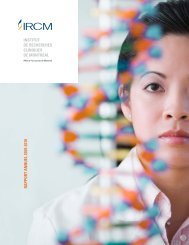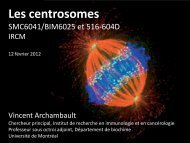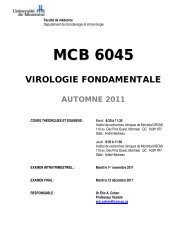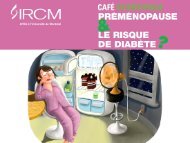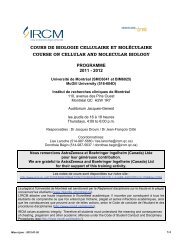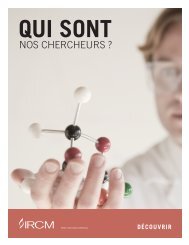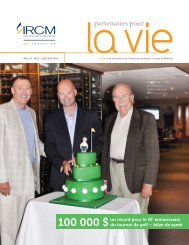Dr Sonenberg - IRCM
Dr Sonenberg - IRCM
Dr Sonenberg - IRCM
You also want an ePaper? Increase the reach of your titles
YUMPU automatically turns print PDFs into web optimized ePapers that Google loves.
Translational controlin eukaryotes<strong>Dr</strong>. Nahum <strong>Sonenberg</strong>Goodman Cancer Research CentreNovember 26, 2013
Eukaryotic mRNA BiosynthesisCapCapA 200CapA 200CapA 200
mRNA Cap• More modification in higher eukaryotes.• m 2,3,7 G in snRNP’s.This position canbe methylatedalso in Cap 1G added by 5’ - 5’ linkageFunctions:Protection (5’exo)TranslationSplicingOther ProcessingPresentin Cap 1Presentin Cap 2PrimaryTranscript
Structure of the 5’-cap
Can label mRNA in capwith a α 32 P-GTP in vitro5’-capping of mRNA
Initiation ofprokaryotictranslation
Shine-Dalgarno SequenceFunctions in Prokaryotes- Consists of 4-9 purine residues on prokaryotic mRNA (upstream from the start codon)- Is required for the recognition of the AUG (sometimes cognate AUG) as initiation codonby the 30S subunit.- A pyrimidine-rich sequence in the 16S rRNA of the 30S ribosomal subunit, which iscomplimentary to the Shine-Dalgarno sequence, mediates ribosomes binding- Aligns the P site of the 30S ribosomal subunit with the AUG (sometimes cognate AUG)
Initiation ofeukaryotictranslation
Simplified Initiation of Translation Pathway, 4H
Ribosome recruitment to mRNA5’secondary structurecapmRNAAUGeIF4EeIF4AeIF4GeIF4F complexeIF4BAUGmRNA unwindingAUGSingle stranded mRNA40S ribosomal subunit recruitment
Composition of eIF4Fe I F 4 GScaffolding proteine I F 4 A+ e I F 4 B h e l i c a s ee I F 4 Ec a p - b i n d i n g s u b u n i t
Protein-Binding Domains in eIF4GIPABPeIF4E2A proeIF3eIF4AeIF4AMnke I F 4 G I1560141112011046642572132
Cap-dependent ribosomerecruitment
mRNA CircularizationAAAAAAAAAAAAAAAAAAAAAAAAAA`PABP4G4ECAPAUG
Cooperation between the 5’ cap and the poly(A)tail in stimulating translation
mRNA Circularization
Consensus Initiation AUGCCAGC C A U G G
Leaky ScanningCap AUG AUG UGA UAA
Termination - Reinitiation40s40sCap ORF1 ORF260s60s60sDisassociates
Leaky Scanning & Reinitiation60s40sUpstream ORF40sDownstream ORF60s60sUpstream ORF60s40s
Models for Ribosome Recruitment5’-end dependent“scanning”40S5’40SAUGInternal binding40S5’40S]IRES/RLPAUG
Pathways of Translation Initiation
Cricket Paralysis Virus RNAWilson et al., NaturallyOccurring Dicistronic CricketParalysis Virus RNA IsRegulated by Two InternalRibosome Entry Sites,Molecular and CellularBiology, July 2000, p.4990-4999, Vol. 20, No. 14Special structural characteristics of cricket paralysis-like virus RNAs. (a) In contrast topicornaviruses, the parts of the RNA coding for non-structural and structural proteins are separatedinto separate open reading frames, ORF1 and ORF2, respectively. (b) It has been proposed thatthe intergenic internal ribosome entry site (IRES) region interacts with the 40S ribosomal subunit insuch a way as to mimic an occupied P-site. The 3' stem-loop structure is thought to form apseudoknot, together with the overlined nucleotides just upstream of the CAA codon used to initiatetranslation of the Plautia stali intestine virus capsid protein.
WHY TRANSLATIONAL CONTROL?1. DIRECTNESS & RAPIDITY(delay due to transcription + processing: < 15min)2. REVERSIBILITY3. FINE CONTROL4. REGULATION OF LARGE GENES5. SYSTEMS THAT LACK TRANSCRIPTIONALCONTROL6. SPATIAL CONTROL7. FLEXIBILITY
Picornaviruses• Rhinovirus – Cold Virus• Poliovirus• Hepatitis A Virus• Encephalomyocarditis Virus
Protein Synthesis in Poliovirus Infected Cells
Protein-binding domains of eIF4GI
Cleavage of EIF4G by Picornaviruses
Ferritin mRNA translational controlIRE-BP absent: mRNA translational IRE-BP bound: no mRNA translation(IRP) (IRP)
TfR mRNA
IRE
Properties of eIF2α protein kinases
Heme depletion inhibits translation in a retic lysate
Interferon-Mediated Inhibition of Translation
Mechanism of PKR Inhibition of Translation
Activation and inhibition of PKR
GCN4 and General Aminoacid Control
translational control of GCN4 expression via reinitiation* non-starvation conditions *travels scansuORF1uORF4GCN4
translational control of GCN4 expression via reinitiation* amino acid-starvation conditions / 3-ATtreatment *travelsscans3-AT resistanceuORF1uORF4GCN4
Control of GCN4 expressionNon-starvation conditionsStarvation conditions
Short-TermMemoryhippocampalconsolidationLong-TermMemorynew protein synthesis
Neuronal activity leading to LTP modulates eIF2α phosphorylationCosta-Mattioli et al.., Nature, 2005Takei et al.., J Biol Cell , 2001
Initiation ofeukaryotictranslationGCN2PERKPKRHRI
ATF4
Translational control of GCN4 mRNA by GCN2 in yeast
Translational control of ATF4ATF4 is a memory repressorprotein (Bartsch et al., Cell,1995 ; Chen et al., Neuron, 2003).Hinnebusch, CSH 2000.
ATF4 represses CREB activityATF4CREImmediate-early genesPL-LTP and long-term memoryCREB
ATF4 represses CREB activity
The Morris Water MazeCameraDistal VisualCuesPlatform Adapted from Sweatt 2003
LTP response and spatial memory functionin parallel in GCN2 -/- mice
Regulation of hunchback mRNA translationby nanos
Anterior-posterior gradients generated bytranslational activation and repressionAnteriorPosterior
Models for cap-dependent translational repression
Translation Control of Cancer
eIF4E Transforms NIH 3T3 CellsMonolayerSoft AgarNIH 3T33T3-pMV7(P)Lazaris-Karatzaset. al.,Nature, 345, 54419903T3-pMV7(C1)3T3-pMV7(C2)
eIF4E is overexpressed (3-10fold) in several cancers includingbreast, colon, prostate, pancreas(30-40%)Rosenwald et.al. Cancer, 2001Rosenwald et. al Oncogene, 1996
The 4E-BPs regulate eIF4FformationeIF4F complexeIF4E4E-BPeIF4EeIF4EeIF4GeIF4Ahormonesgrowth factorsmitogenscytokinesGPCR agonistsadenovirusPP P P4E-BPserum starvationamino acid deprivationEMCVpoliovirusenvironmental stress
Signaling pathway to 4E-BP1 phosphorylationgrowth factorswortmanninPI3KAkt/PKBrapamycinFRAP/mTOR4E-BP1
Cap-dependent ribosome recruitment40S4E m 7 GeIF4GeIF34AeIF2/Met-tRNA/GTPAUGORF
Cap-dependent ribosome recruitmenteIF340S4E-BPeIF4G4AeIF2/Met-tRNA/GTPAUG4Em 7 GORFPause et. al., Nature, 361, 762,1994Poulin et. al., JBC, 273, 1998
The 4E-BPs activity is regulated by phosphorylationGingras et al. G&D, 1999
The PI3 kinase-Akt/PKB-FRAP/mTOR modulePI3 KinasePTENAMPKAkt/PKB? FRAP/mTOR RhebTsc2TSC-2Tsc1Gao et al, Nature Cell Biol, 2002Potter et al, Nature Cell Biol, 2002Zhang et al, Nature Cell Biol, 2003Inoki et al, Cell 2003TARGETSRapamycin4E-BPs, S6K, eIF4B, eIF4G
Involvement of the PI3 KinasePathway in CancerPI3 Kinase (amplified in cancers)OncogenePTENMutated in CancersTumor SuppressorAkt/PKB (amplified in cancers)OncogeneFRAP/mTORTuberous Sclerosis Complex (TSC)Mutated in CancersTumor Suppressor4E-BP1 (reverts the phenotype of transformed cells,sensitizes ras-transformed cells to apoptosis)
Rapamycin(CCI-779;RAD001;AP23573)ImmunosuppressantIn the clinic heart-valve stentsAnti-cancer drug-RCCCCI-779 (Wyeth); RAD001 (Novartis)NOT HIGHLY POTENT!
microRNAsmiRNA are 21-23nt small RNAs processed from a genome-encoded hairpinMediate translational control, sometimes cleavage, sometimes destabilizationof target mRNAConstitute ~1% of the genome, and regulate up to 30% of the genesLinked to cell division, differentiation, apoptosis, cell-specific roles,and are linked to viral and oncogene regulation
miRNA-mediated repression of protein accumulation(A)Initiation arrest(B) Post-initiation arrest & ribosome drop-offAAAAAAAAmiRNPRibosome run-offand mRNA aggregationStressGranule?miRNP(C) ProteolysisProteaseAAAAmiRNPAAAAP-bodyDecaymRNAStoragemiRNPmiRNP(D) Deadenylation & mRNA decayGW182CCR4:AAAANOT1miRNPmRNA exit and re-usemRNA decay
mRNAsRLCapR-LucPoly(A)RL-6xBCapR-LucPoly(A)5’UGAU AGCACAGCCUA CUACCUCA3’ UUGAUAUGUUGGAUGAUGGAGU3’5’mRNALet-7aMathonnet et al. Science, 2007
Repression of protein synthesis by let-7 miRNA inKrebs-2 ascites extractImportance of target mRNA concentration fortranslation inhibition by endogenous miRNA% of translation relative to RL1008060402003 0.3 0.03 0.003RL-6xB mRNA [nM]Maximum inhibition reached at 0.03nM of RNA+pA (10pg/ul)Mathonnet et al. Science, 2007
Specific inhibition of Let-7a by 2’ O Me oligonucleotidesLuciferase activity (RLU x 10 4 ) 302520151050.03nM mRNARLpA6xBpA02ʼ-O-Me antisense:Let-7a [nM]__1010.1miR-122a [nM]_10_ _ _% translation vs RL 28 29 71 49 28
Mutating the let-7 target sites rescues translationRL-6xBMutCap5’R-LucUGAU A CC…GCACAGCCUA CUACC UCA… 3’3’ UUGAUAUGUUGGAUGAUGGAGU5’Poly(A)mRNALet-7a% Relative Rluc activity
No inhibition in a wheat germ extract (noLet-7a in plants)Relative Rluc activityRLpA6xBpA0.3 0.03mRNA [nM]
Kinetics of in vitro translation in Krebs extract• No inhibition in the first 10 min of the translation reaction• assembly of the RISC?
let-7 miRNA inhibits translation initiation
let-7 miRNA does not inhibit EMCV IRES -mediated translationAEMCV-RLEMCVIRESR-LucPoly(A)EMCV-RL-6xBEMCVIRESR-LucPoly(A)
Ribosome recruitment to mRNA5’secondary structurecapmRNAAUGeIF4EeIF4AeIF4GeIF4F complexeIF4BAUGmRNA unwindingAUGSingle stranded mRNA40S ribosomal subunit recruitment
Supplementing the Krebs-2 Ascites extract witheIF4F complex restored translation of the let-7 targetmRNATranslation RL-6xB (% of RL)RL-6xBRL-6xB + 2ʼ-O-MeeIF4F [ng/µl]
Translational Control ofAutism
Autism Spectrum Disorders• Autism Spectrum Disorders• cognitive impairment• impaired social interaction and relationships• repetitive/stereotypic behaviors• impaired language and communication• The “autism hypothesis” : molecular dysregulation duringdevelopment can impair mature brain circuits and lead to ASD.Leo Kanner publishedhis first paperidentifying autisticchildren in 1943,asserting he hadnoticed such childrensince 1938 Autism~ from the Greekword «αυτός»,whichmeans self---indicateswithdrawal of oneself fromthe fabric of social life
Neuronal Translation and ASDKelleher & Bear Cell 2008
The Journal of Neuroscience, February 11, 2009 • 29(6):1773–1783 • 1773Cellular/MolecularPharmacological Inhibition of mTORC1 SuppressesAnatomical, Cellular, and Behavioral Abnormalities inNeural-Specific Pten Knock-Out MiceJing Zhou, 1 Jacqueline Blundell, 2 Shiori Ogawa, 3 Chang-Hyuk Kwon, 1 Wei Zhang, 1 Christopher Sinton, 3Craig M. Powell, 2,4 and Luis F. Parada 11Department of Developmental Biology and Kent Waldrep Foundation Center for Basic Neuroscience Research on Nerve Growth and Regeneration, andDepartments of 2 Neurology, 3 Internal Medicine, and 4 Psychiatry, University of Texas Southwestern Medical Center, Dallas, Texas 75390PTEN (phosphatase and tensin homolog deleted on chromosome ten) is a lipid phosphatase that counteracts the function ofphosphatidylinositol-3 kinase (PI3K). Loss of function of PTEN results in constitutive activation of AKT and downstream effectors andcorrelates with many human cancers, as well as various brain disorders, including macrocephaly, seizures, Lhermitte–Duclos disease,and autism. We previously generated a conditional Pten knock-out mouse line with Pten loss in limited postmitotic neurons in the cortexand hippocampus. Pten-null neurons developed neuronal hypertrophy and loss of neuronal polarity. The mutant mice exhibited macrocephalyand behavioral abnormalities reminiscent of certain features of human autism. Here, we report that rapamycin, a specificinhibitor of mammalian target of rapamycin complex 1 (mTORC1), can prevent and reverse neuronal hypertrophy, resulting in theamelioration of a subset of PTEN-associated abnormal behaviors, providing evidence that the mTORC1 pathway downstream of PTEN iscritical for this complex phenotype.Key words: PTEN; tuberous sclerosis complex; autism; macrocephaly; neuronal hypertrophy; neuronal polarityIntroductionPTEN (phosphatase and tensin homolog deleted on chromoalyand additional behavioral abnormalities reminiscent of humanautism, including reduced social activity, increased anxiety,
PTEN TSCmTORupstream4E-BP4E-BP14E-BP24E-BP3eIF4EASD
• Autism Spectrum Disorders (ASD)• cognitive impairment• impaired social interaction and relationships• repetitive/stereotypic behaviors• impaired language and communication
• Autism Spectrum Disorders (ASD)• cognitive impairment• impaired social interaction and relationships• repetitive/stereotypic behaviors• impaired language and communication
Genetic deletion of 4E-BP2 leads to socialinteraction deficitsaTime spent inchamber (s)#entriesTime spentsniffing (s)ding bout duration(s)3 chamber6005004003002001000504030201002001501005001210864****nsWT*******eStranger 1CenterEmpty4E-BP2 KOarbles burried**ns*201510bc*homecage-familiarTotal time in contact(s)f300250200150100500150100ber of calls/min5006050403020WT-WTWT-KOKO-KOnew cage-unfamiliarTotal time in contact(s)WT-WT*****WT-KOnsnsKO-KOWTNumber of contactsNumber of contacts* * *35302520151050403020100WT-WTWT-WT**nsWT-KOns* *WT-KOKO-KOKO-KO4E-BP2 KO* *WTor4E-BP2KOsurgeryinfusionrecovery7 d
• Autism Spectrum Disorders (ASD)• cognitive impairment• impaired social interaction and relationships• repetitive/stereotypic behaviors• impaired language and communication
Test#e20100200Repetitive/Stereotyped behaviors *** in 4E-BP2 KOsTestrecoverysurgeryinfusion7 dWTor4E-BP2KOTime spentsniffing (s)dGrooming bout duration(s)gDuration of calls(ms)1501005001210864206050403020100pndWTWT 4E-BP2KO*WT**4E-BP2 KOeMarbles burried2015104E-BP2 KO* * * * *WTor4E-BP2KO*2 4 6 8 1250*WT 4E-BP2KOhTotal time in contact(s)Peak amplitude (dB)f150100Number of calls/min5000loud-10-20-30-40soft-506050403020100pndpndWT-WT**WT-KOnsKO-KOWT* * *WTNumber of contacts403020104E-BP2 KO* *2 4 6 8 124E-BP2 KO2 4 6 8 120WT-WTnsWT-KO*KO-KO* *7 dFigure 1-Gkogkas_2012-01-00380Brecoverysurgeryinfusion
• Autism Spectrum Disorders (ASD)• cognitive impairment• impaired social interaction and relationships• repetitive/stereotypic behaviors• impaired language and communication
Altered Ultrasonic Vocalizations in 4E-BP2 pupsNumber of calls/minDuration of calls(msec)6050403020100pnd 2 4 6 8 126050403020100pnd!"!#"!#"#2 4 6 8 12!"!#"!#"#Peak Amplitude(Decibel)softloud0-10-20-30-40-50"#" "#$ $#$pnd 2 4 6 8 12Isolation5 minRECORD! !Reunion
• eIF4E hyperactivation preferentiallyenhances the translation of a subset ofmRNAs termed “eIF4E sensitive”.
Increased translation of neuroligins in 4E-BP2 KO or βT-eIF4E miceabgRNPs10%40S60SRNPs10%80S4E-BP2 WT4E-BP2 KOpolysomes60S40S80SWTpolysomes50%c4E-BP2 WT4E-BP2 KOWT50%dWTKO4E WT 4E WT 4E WT 4E WT 4E WT 4E WT KO WT KO WT KO WT KO WT KO WTRNPsRNPs40S60S80S40S60S*80SpolysomespolysomeshNlgn1 Nlgn2 Nlgn3 Nlgn4 Dlg4 Actb Nlgn1 Nlgn2 Nlgn3 Nlgn4 Dlg4 ActbefcrudeWT KO WTcrudeWT 4E4E-BP2 KOWTKO4ENLGN 1NLGN 2NLGN RNPs 3NLGN 3NLGN 2NLGN 4PSD-95Arc/Arg3.1GFAPPolr2a4E-BP2NLGN 1NLGN 2NLGN 1 NLGN 2 NLGNNLGN3 NLGN34 NLGN 1 NLGN 2 NLGN 3 NLGN 4* ** NLGN * 3** * *1.2NLGN 2NLGN 4PSD-95Arc/Arg3.1GFAP .Polr2aeIF4ENLGN 1 NLGN 2 NLGN 3 NLGN 4 NLGN 1 NLGN 2 NLGN 3 NLGN 4bg10%RNPs10%1.20.80.4060S40S*WTKOWTKOcr.80S.WTpolysomesWTKOWTKOcr.4E-BP2 WTWT.50%50%* *dWTKOWTKOcr.4E WT 4E WT 4E WT 4E WT 4E WT 4E WT KO WT KO WT KO WT KO W*80SWTKOWTKOcr.40S60S.gh10%polysomes1.20.80.400.80.4040S*WTKOWTKOcr.gn3 Nlgn4 Dlg4 Actb Nlgn1 Nlgn2 Nlgn3 Nlgn4 Dlg4 Actb* ** *.fWTKOWTKOcr.WT.50%crudeWT 4EWTWTKOWTKOcr.4E WT 4E WT 4E WT 4E WT4E*PSD-95Arc/Arg3.1GFAPPolr2a4E-BP2WTKOWTKO. Arc/Arg3.1cr. .hNlgn3 Nlgn4 Dlg4ActbNLGN 1 NLGN 2 NLGN 3 NLGN 14 NLGNNLGN * 2WT4EWT4Ecr..WT4EWT4Ecr..WT4EWT4Ecr..NLGN 3NLGN * 3NLGN 2NLGN 4PSD-95GFAPPolr2aeIF4EWT4EWT4Ecr..1.20.80.40WT4EWTcr.*
Nlgn1: excitatory synapsesNlgn2: inhibitory synapsesNlgn3: excitatory & inhibitorysynapsesNlgn4: inhibitory synapses
1_w25_85 GGGCUCACUGGAGUGGCAGAUAUAG ((((.((((..))))))))......2_w25_133 CCCGGCGGCGGCGCCCCGGGCGGCC (((((((((((..))))))))))).2_w25_161 GCCUGGGCCUCGGCAGCCUCGGCGA (((.(((((((..))))))))))..2_w25_17 UCUCUCUCUCCGAGGGGGGGGGGUCa(((((((((((..))))))))))).2_w25_223 GUGCGCGGUGUGCGGCGCGAGCUCA ((((((((((..))))))))))...2_w25_451 UUGGAGGCGGCCGCCACCUACGUGC (((((((((..))))))))).....2_w25_514 GUGCCCACCGAGGACGGUCCGCUCA (((((((((((..))))))))))).5!UTR Nlgn 12_w25_51 GAGGGGGGGUCCCCCGAUCAGCAUG ((((((((..))))).)))......3_w25_87 GCUGUGUCUGGUGGGGCUGGCGGGG .(((((((((((..)))))))))))3_w25_146 CUGAGGGAGUCCCCUUUCUGAAGCU ((((((((((..))))))))).)..5!UTR Nlgn 23_w25_299 a AGUCUGCCUCUCCUGCCAGUCCCCC ((((((((((..))))))))))...4x_w25_67 CUUGGCCUGGAGGCGAUAUGGGUGG ((((((((..)))))).).).....4x_w25_168 GAGUUUUCAUAAGAAAUUGUCCCUG (((((((((..))))))).))....4x_w25_256 AAGGGAGGGCUGCCUCCUUGCAAUG 5!UTR Nlgn 1(((((((((..))))))))).....5!UTR Nlgn 34x_w25_289 AGAAAACGGCUGUGCUUGUUCUUAA (((((((((((..))))))))))).4x_w25_356 UCUACUGCUCCCUGGAAAGCCCUAU ..((((((((((..)))))))))).4x_w25_404 CUUUGUCUCCUUGGAGCCACAUCAC ((((((((((..))))))))).)..5!UTR Nlgn 4x5!UTR Nlgn 25!UTR Nlgn 3nlgn1human_w25_415!UTR Nlgn 4xbbC AC C 15>nlgn1_w25_183 AUGGAAAACAGAAUGUUCAAUAGGA (((((((((..))).))))))....GU>nlgn1_w25_283 GAAGAUCUUUCAGAGCUUUUCUCGA (((((((((..).))))))))....10 G C >nlgn1_w25_41 AAGCUUGAGGCCACUCAAGUUCCAA ((((((((((..))))))))))...A A >nlgn1_w25_85 GGGCUCACUGGAGUGGCAGAUAUAG ((((.((((..))))))))......GA>nlgn2_w25_133 CCCGGCGGCGGCGCCCCGGGCGGCC (((((((((((..))))))))))).>nlgn1_w25_183 U G 20>nlgn2_w25_161 GCCUGGGCCUCGGCAGCCUCGGCGA (((.(((((((..))))))))))..AUGGAAAACAGAAUGUUCAAUAGGA >nlgn2_w25_17 (((((((((..))).))))))....UCUCUCUCUCCGAGGGGGGGGGGUC (((((((((((..))))))))))).>nlgn1_w25_283 U UGAAGAUCUUUCAGAGCUUUUCUCGA >nlgn2_w25_223 (((((((((..).))))))))....GUGCGCGGUGUGCGGCGCGAGCUCA ((((((((((..))))))))))...>nlgn1_w25_41 5 CU 25C AAGCUUGAGGCCACUCAAGUUCCAA >nlgn2_w25_451 ((((((((((..))))))))))...UUGGAGGCGGCCGCCACCUACGUGC (((((((((..))))))))).....>nlgn1_w25_85 CGGGGCUCACUGGAGUGGCAGAUAUAG A A >nlgn2_w25_514 ((((.((((..))))))))......GUGCCCACCGAGGACGGUCCGCUCA (((((((((((..))))))))))).>nlgn2_w25_133 ACCCGGCGGCGGCGCCCCGGGCGGCC >nlgn2_w25_51 (((((((((((..))))))))))).GAGGGGGGGUCCCCCGAUCAGCAUG ((((((((..))))).)))......>nlgn2_w25_161 GCCUGGGCCUCGGCAGCCUCGGCGA >nlgn3_w25_87 (((.(((((((..))))))))))..GCUGUGUCUGGUGGGGCUGGCGGGG .(((((((((((..)))))))))))>nlgn2_w25_17 A UCUCUCUCUCCGAGGGGGGGGGGUC >nlgn3_w25_146 (((((((((((..))))))))))).CUGAGGGAGUCCCCUUUCUGAAGCU ((((((((((..))))))))).)..>nlgn2_w25_223 GUGCGCGGUGUGCGGCGCGAGCUCA >nlgn3_w25_299 ((((((((((..))))))))))...AGUCUGCCUCUCCUGCCAGUCCCCC ((((((((((..))))))))))...>nlgn2_w25_451 UUGGAGGCGGCCGCCACCUACGUGC >nlgn4x_w25_67 (((((((((..))))))))).....CUUGGCCUGGAGGCGAUAUGGGUGG ((((((((..)))))).).).....>nlgn2_w25_514 GUGCCCACCGAGGACGGUCCGCUCA >nlgn4x_w25_168 (((((((((((..))))))))))).GAGUUUUCAUAAGAAAUUGUCCCUG (((((((((..))))))).))....>nlgn2_w25_51 dG = +0.00 GAGGGGGGGUCCCCCGAUCAGCAUG >nlgn4x_w25_256 ((((((((..))))).)))......AAGGGAGGGCUGCCUCCUUGCAAUG (((((((((..))))))))).....>nlgn3_w25_87 GCUGUGUCUGGUGGGGCUGGCGGGG>nlgn4x_w25_289.(((((((((((..)))))))))))AGAAAACGGCUGUGCUUGUUCUUAA (((((((((((..))))))))))).>nlgn3_w25_146 CUGAGGGAGUCCCCUUUCUGAAGCU ((((((((((..))))))))).)..Supplementary Figure 14-Gkogkas_2012-01-00380B>nlgn4x_w25_356 UCUACUGCUCCCUGGAAAGCCCUAU ..((((((((((..)))))))))).>nlgn3_w25_299 AGUCUGCCUCUCCUGCCAGUCCCCC ((((((((((..))))))))))...>nlgn4x_w25_404 CUUUGUCUCCUUGGAGCCACAUCAC ((((((((((..))))))))).)..>nlgn4x_w25_67 CUUGGCCUGGAGGCGAUAUGGGUGG ((((((((..)))))).).).....>nlgn4x_w25_168 GAGUUUUCAUAAGAAAUUGUCCCUG (((((((((..))))))).))....>nlgn4x_w25_256 AAGGGAGGGCUGCCUCCUUGCAAUG (((((((((..))))))))).....>nlgn4x_w25_289 AGAAAACGGCUGUGCUUGUUCUUAA (((((((((((..))))))))))).>nlgn4x_w25_356 UCUACUGCUCCCUGGAAAGCCCUAU ..((((((((((..)))))))))).nlgn1human_w25_41>nlgn4x_w25_404 CUUUGUCUCCUUGGAGCCACAUCAC ((((((((((..))))))))).)..nlgn1human_w25_41c
ASD treatment strategies?
4EGI-1• cell-permeable hydrazone• reversibly binds eIF4E• disrupts eIF4E/eIF4G, but not eIF4E/4E-BP1• KD = 25 µMInhibition of the interactions between eukaryoticinitiation factors 4E and 4G impairs long-term associativememory consolidation but not reconsolidationCharles A. Hoeffer a,b,1 , Kiriana K. Cowansage a,1 , Elizabeth C. Arnold c , Jessica L. Banko d , Nathan J. Moerke e ,Ricard Rodriguez f , Enrico K. Schmidt g , Edvin Klosi h , Michael Chorev h , Richard E. Lloyd i , Philippe Pierre g ,Gerhard Wagner f , Joseph E. LeDoux a , and Eric Klann a,2a Center for Neural Science, New York University, New York, NY 10003; b Smilow Neuroscience Program, Department of Neuroscience and Physiology,New York University School of Medicine, New York, NY 10016; c Neuroscience Research Unit, Pfizer Global Research and Development, Groton, CT 06340;d Department of Molecular Medicine, University of South Florida, Tampa, FL 33612; e Institute of Chemistry and Cellular Biology-Longwood, f Departmentof Biological Chemistry and Molecular Pharmacology, and h Laboratory for Translational Research, Harvard Medical School, Boston, MA 02115; g Centred’Immunologie de Marseille-Luminy, Unité Mixte de Recherche 6102 Centre National de la Recherche Scientifique, Université de la Méditerranée, Case906, 13288 Marseille, France; and i Department of Molecular Virology and Microbiology, Baylor College of Medicine, Houston, TX 77030Edited* by Richard F. Thompson, University of Southern California, Los Angeles, CA, and approved January 12, 2011 (received for review September 2, 2010)



